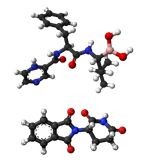Novel Agents Now Prevalent Method of Care for Multiple Myeloma
A majority of patients with multiple myeloma are being treated with novel agents such as thalidomide, bortezomib, and lenalidomide within a year of diagnosis instead of the chemotherapeutic regimens that were more prevalent a decade ago, according to a new study.
A large majority of patients with multiple myeloma are being treated with novel agents such as thalidomide, bortezomib (Velcade), and lenalidomide within the first year of diagnosis instead of the chemotherapeutic regimens that were more prevalent a decade ago, a new study indicated.

Ball-and-stick models of bortezomib (top) and thalidomide (bottom)
“Multiple myeloma treatment practices have changed appreciably over the past decade,” said Joan L. Warren, PhD, lead author and epidemiologist in the health services and economics branch at the National Cancer Institute. “While there has been anecdotal reporting of how treatment has changed, there were limited data detailing the specifics of changes in treatment among the general population of myeloma patients prior to this study.”
Warren and colleagues examined data from 1,976 patients who were newly diagnosed with myeloma in 1999, 2003, and 2007. They assessed patient treatment during the first year after diagnosis, with either:
• Common chemotherapies: melphalan, vincristine, and doxorubicin
• Novel agents: thalidomide, bortezomib, or lenalidomide
• Hematopoietic stem-cell transplantation
The results were published in the Journal of Clinical Oncology.
From 1999 to 2007, the percentage of patients receiving melphalan decreased from 32% to 4.1%. Use of other common chemotherapies also decreased, with vincristine and doxorubicin use decreasing from 18.2% to 0.4% during the same period.
In contrast, the use of novel drugs during the first year after diagnosis increased significantly. Although only about 4% of patients were receiving any novel agent in 1999, by 2007, 75.5% of patients were getting novel therapies. Patients receiving hematopoietic stem-cell transplantation also increased from 11.1% in 1999 to 21.7% in 2007.
“It is unusual to find such a rapid adoption of new cancer therapy,” Warren said. “In this case, ease of administration, effectiveness, and a better side effects profile likely contributed to the rapid pace of adopting the new treatments seen in this study.”
The three novel drugs examined have resulted in significant increases in survival for myeloma patients, according to Warren.
“These treatments are expensive,” Warren said. “Annual out-of-pocket expenses from 2005 to 2007 were estimated to be $4,443 for thalidomide, $3,504 for bortezomib, and $4,766 for lenalidomide, creating issues with accessibility for patients who are not well insured or do not have the income to afford the copayments.”
The researchers also assessed if patient race or insurance status limited accessibility to treatment with the more expensive novel agents.
Type of insurance was associated with the type of treatment received; however, results varied by race. Among white patients, type of insurance was not significantly associated with the likelihood of receiving novel agents. However, among patients of other races, only 38% of patients with Medicare and 36.3% of patients with Medicaid received novel agents compared with 47.3% of patients with private insurance.
“These findings suggest that access to expensive treatment may be an issue for myeloma patients who do not have insurance to help with copayments, as noted with the Medicare-only group,” Warren said.
Based on the results of this study, physicians and patients should understand that myeloma treatments are expensive and that not all patients can afford the copayments for their medications.
Newsletter
Stay up to date on recent advances in the multidisciplinary approach to cancer.